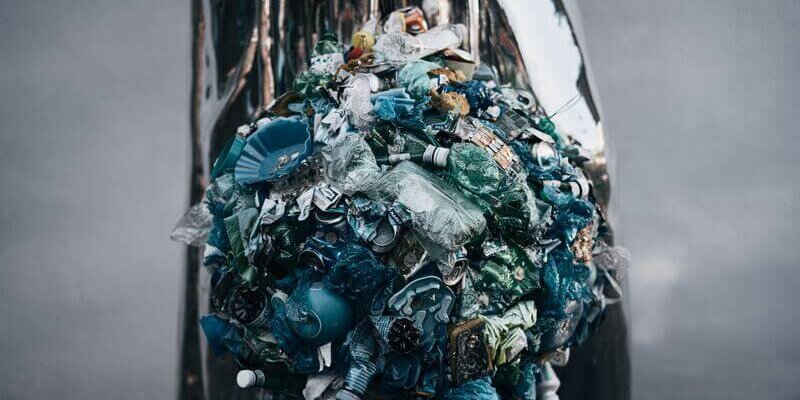Posted Aug 30th, 2023

We understand that after reducing our fabric wastage, the next step we need to take to ensure circularity is recycling. Recycling holds significant importance in fashion marketing as well. Fabric crafted from post-consumer plastic bottles? Absolutely. Swimwear created from discarded fishing nets? Certainly. But is the current infrastructure truly circular? And what follows in the process?
Let’s delve deeply into recycled and recyclable synthetic fabrics. For this article, we focus on fabrics woven or knitted from polyester, polyamide, acrylic, and elastan. We exclude non-woven materials used in footwear or accessories, as well as fibers like polypropylene and other elastomers. Our attention is solely on the synthetics derived from bitumen, whether virgin or recycled.
At De Ronde Creative Hub, we possess a fervent commitment to waste reduction, given its substantial impact on the textile industry. As a sportswear supplier, synthetics play a substantial role in our production. An extensive study by Reverse Resources Bangladesh in 2019 revealed that “leftovers” (including yarns, cutting scraps, roll ends, overproduction, and rejected pieces) can sometimes account for up to 47% of the total raw material input. Even with optimised methods, the volume rarely dips below 20%. (Source: Read Article Here) While apparel manufacturing produces less waste compared to spinning and wet processing, it still generates more than fabric weaving or knitting. Nevertheless, all these figures pale in comparison to the amount discarded post-sale.
Synthetic waste emerges at various stages during production, each presenting its unique challenges. Garment creation results in plastic waste during the spinning process, sometimes as much as 15%, as noted in a 2022 report that examined waste reduction models in Bangladesh. (Source: Read Article Here) Spinning waste encompasses lint, damaged yarn, and incomplete cones. Fabric production, whether knitting or weaving, also produces waste, albeit generally less if quality yarns are selected, and defects and colour mismatches are minimised. Additional waste is generated on the cutting room floor, constituting up to 26% of the garment, depending on style and quantity. All of this falls under the category of pre-consumer waste.
Pre-consumer waste is relatively easier to recycle since it’s usually sorted and mostly uncontaminated. Contamination typically arises from dyes, finishes, or mixed blends, but such information can be communicated to recyclers. Mixed blends pose challenges in closed-loop recycling, often leading to incineration for energy. Carbios, a French chemical recycler of polyester fabrics utilising enzymes, highlights that recycling fabric with less than 85% polyester isn’t commercially viable due to the cost of producing new resin. Notably, Carbios stands out by transforming waste polyester fabric into plastic bottles and textiles. However, scaling this process remains the next milestone, with a facility anticipated to open in 2025, accommodating 60 million tons of PET in both bottle and textile forms.
The bulk of polyester waste destined for landfills is post-consumer waste. This category includes garments already manufactured and sent to retailers, irrespective of whether they’ve been sold to consumers. Approximately 1% of recycled garments become new clothes, while the remainder is incinerated for energy or accumulates in clothing mountains. Sorting and eliminating non-recyclable parts pose significant challenges in post-consumer recycling and can be cost-intensive.
In early 2023, the EU Commission rejected bottled water companies’ plea for priority access to recovered PET plastic bottles, a crucial feedstock for recycled polyester. About 60% of plastic bottles are recycled, with only around 17% of recycled plastics found in food-safe bottles. The rest trickles into textile applications. The EU cited anti-competition laws as the reason for refusal. Multiple organisations worldwide strive to render polyester fabrics more recyclable into new fibres or plastic bottles, given polyester’s dominance, constituting around 60% of global fabric sales. To acquire a Global Recycling Standard (GRS) certificate, fabric or yarn must comprise a minimum of 30% recycled content. Most recycled polyester yarns boast an average of 50% recycled content, while incorporating over 20% elastane into finished fabric necessitates around 70% recycled yarn. Hence, it’s essential to discern whether yarn or finished fabric holds GRS certification.

Polyamide, although less common in fashion, finds extensive use in sportswear due to its lightweight, robustness, and elasticity. Despite its water retention, which makes it suitable for bottoms and outerwear, it’s frequently blended with elastane for skin-tight sportswear bottoms. While polyamide and elastane share similar properties, recent advancements allow the separation and recycling of the two fibres through chemical processes. However, challenges persist, especially in recycling elastane, often present in blends, and requiring specialised extraction methods.
Unfortunately, acrylic cannot be recycled in a fibre-to-fibre capacity. While recycling is possible, its application in fashion is limited, frequently blended and dyed. As a result, many acrylic recyclers avoid it, particularly without compensation. Acrylic’s primary fashion application lies in imitating wool for knitwear, offering comfort and easy care. Nevertheless, its tendency to pill quickly diminishes its resale value. While microfibre pollution garners attention, only a tiny fraction originates from consumer garment washing. Established wastewater treatment systems remove 98% of machine-shed microfibres. The ocean’s bulk comes from disposed garments and manufacturing processes, with less than 2% from washing clothes.
So, how can brands facilitate more accessible recycling of their products?

First, limit blends whenever possible. Mono-component garments gained prominence for a reason, as it’s feasible to make a garment entirely from polyester, including buttons and trims, enabling mechanical recycling. This method requires fewer chemicals and less energy than chemical recycling, but it can degrade the raw material. In contrast, chemical processes maintain the polymer building blocks. Pay attention to sewing threads; they need to match the garment’s composition.
Blends with mixed compositions must be chemically recycled to separate distinct fibre types. Chemical recycling poses a challenge concerning the leftover “slurry” containing chemicals and stripped fabric contaminants. This mixture, comprising dyes, finishes, and various fiber compositions, is problematic for disposal, as its constituents can’t be isolated.
Brands also need to effectively communicate garment composition to wearers or recyclers, beyond relying solely on care labels. In some regions, care labels aren’t legally required to accurately reflect composition. The UK, for instance, mandates only 3% accuracy. Even fibres below 1% can contaminate mechanical recycling processes. Furthermore, care labels establish a binding contract between brands and purchasers.
Lastly, advocating for design that facilitates disassembly for garments not suitable as mono-component items is crucial. Innovative solutions like dissolvable sewing threads and recyclable metal accessories are emerging but remain costly and experimental. Buttons could surpass poppers in end-of-life scenarios, especially if wearers are encouraged to disassemble garments before recycling. Another approach involves designing products that can transform into something else after their primary use, extending their lifecycle.
For more insight into our recycling process or to explore how we can assist in designing, developing, and manufacturing easily recyclable ranges, please contact us at info@derondecreativehub.com.